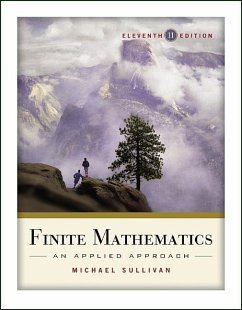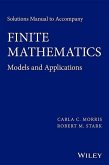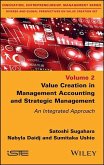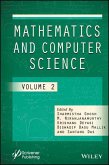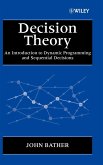- Gebundenes Buch
- Merkliste
- Auf die Merkliste
- Bewerten Bewerten
- Teilen
- Produkt teilen
- Produkterinnerung
- Produkterinnerung
Now in its Eleventh Edition, this text once again lives up to its reputation as a clearly written, comprehensive finite mathematics book. The Eleventh Edition of Finite Mathematics builds upon a solid foundation by integrating new features and techniques that further enhance student interest and involvement. All existing problems have been updated to provide relevance and timeliness. This new edition of Finite Mathematics contains the same elements such as Step-by-Step Examples, Exercise Sets, and Learning Objectives in every chapter. In an engaging and accessible style, this text demonstrates…mehr
Andere Kunden interessierten sich auch für
![Solutions Manual to Accompany Finite Mathematics Solutions Manual to Accompany Finite Mathematics]() Carla C MorrisSolutions Manual to Accompany Finite Mathematics32,99 €
Carla C MorrisSolutions Manual to Accompany Finite Mathematics32,99 €![Value Creation in Management Accounting and Strategic Management Value Creation in Management Accounting and Strategic Management]() Satoshi SugaharaValue Creation in Management Accounting and Strategic Management169,99 €
Satoshi SugaharaValue Creation in Management Accounting and Strategic Management169,99 €![Fuzzy Logic Applications in Computer Science and Mathematics Fuzzy Logic Applications in Computer Science and Mathematics]() Fuzzy Logic Applications in Computer Science and Mathematics186,99 €
Fuzzy Logic Applications in Computer Science and Mathematics186,99 €![Applications of Statistics to Industrial Experimentation Applications of Statistics to Industrial Experimentation]() Cuthbert DanielApplications of Statistics to Industrial Experimentation314,99 €
Cuthbert DanielApplications of Statistics to Industrial Experimentation314,99 €![Mathematics and Computer Science, Volume 2 Mathematics and Computer Science, Volume 2]() Mathematics and Computer Science, Volume 2222,99 €
Mathematics and Computer Science, Volume 2222,99 €![Decision Theory Decision Theory]() John BatherDecision Theory257,99 €
John BatherDecision Theory257,99 €![Markov Chains Markov Chains]() Bruno SericolaMarkov Chains169,99 €
Bruno SericolaMarkov Chains169,99 €-
-
-
Now in its Eleventh Edition, this text once again lives up to its reputation as a clearly written, comprehensive finite mathematics book. The Eleventh Edition of Finite Mathematics builds upon a solid foundation by integrating new features and techniques that further enhance student interest and involvement. All existing problems have been updated to provide relevance and timeliness. This new edition of Finite Mathematics contains the same elements such as Step-by-Step Examples, Exercise Sets, and Learning Objectives in every chapter. In an engaging and accessible style, this text demonstrates how mathematics applies to various fields of study. The text is packed with real data and real-life applications to business, economics, social and life sciences.
Hinweis: Dieser Artikel kann nur an eine deutsche Lieferadresse ausgeliefert werden.
Hinweis: Dieser Artikel kann nur an eine deutsche Lieferadresse ausgeliefert werden.
Produktdetails
- Produktdetails
- Verlag: Wiley
- 11th edition
- Seitenzahl: 864
- Erscheinungstermin: 6. September 2011
- Englisch
- Abmessung: 260mm x 213mm x 35mm
- Gewicht: 1594g
- ISBN-13: 9780470458273
- ISBN-10: 0470458275
- Artikelnr.: 32732145
- Herstellerkennzeichnung
- Libri GmbH
- Europaallee 1
- 36244 Bad Hersfeld
- gpsr@libri.de
- Verlag: Wiley
- 11th edition
- Seitenzahl: 864
- Erscheinungstermin: 6. September 2011
- Englisch
- Abmessung: 260mm x 213mm x 35mm
- Gewicht: 1594g
- ISBN-13: 9780470458273
- ISBN-10: 0470458275
- Artikelnr.: 32732145
- Herstellerkennzeichnung
- Libri GmbH
- Europaallee 1
- 36244 Bad Hersfeld
- gpsr@libri.de
Michael Sullivan is Professor Emeritus in the Department of Mathematics and Computer Science at Chicago State University where he taught for 35 years before retiring a few years ago. Dr. Sullivan is a member of American Mathematical Society, the Mathematical Association of America, and the American Mathematical Association of Two Year Colleges. He is President of Text and Academic Authors Association and represents that organization on the Authors Coalition of America, Mike has been writing textbooks in mathematics for over 30 years. He currently has 13 books in print: 3 texts with John Wiley & Sons and 10 with Prentice-Hall. Six of these titles are co-authored with his son, Michael Sullivan III. He has four children: Kathleen, who teaches college mathematics; Michael, who teaches college mathematics, Dan who is a Prentice-Hall sales representative, and Colleen, who teaches middle school mathematics. Nine grandchildren round out the family.
Chapter 1: Linear Equations.
1.1. Lines.
1.2. Pairs of Lines.
1.3. Applications to Business and Economics.
1.4. Scatter Diagrams; Linear Curve Fitting.
Chapter Review.
Chapter Project.
Chapter 2: Systems of Linear Equations.
2.1 Systems of Linear Equations: Substitution; Elimination.
2.2 Systems of Linear Equations: Gauss-Jordan Method.
2.3 Systems of m Linear Equations Containing n Variables.
Chapter Review.
Chapter Project.
Chapter 3: Matrices.
3.1 Matrix Algebra.
3.2 Multiplication of Matrices.
3.3 The Inverse of a Matrix.
3.4 Applications in Economics (the Leontief Model), Accounting, and
Statistics (the Method of Least Squares).
Chapter Review.
Chapter Project.
Chapter 4: Linear Programming with Two Variables.
4.1 Systems of Linear Inequalities.
4.2 A Geometric Approach to Linear Programming Problems.
Chapter Review.
Chapter Project.
Chapter 5: Linear Programming: Simplex Method.
5.1 The Simplex Tableau; Pivoting.
5.2 The Simplex Method; Solving Maximum Problems in Standard Form.
5.3 Solving Minimum Problems Using the Daily Principle.
5.4 The Simplex Method for Problems Not in Standard Form.
Chapter Review.
Chapter Project.
Chapter 6: Finance.
6.1 Interest.
6.2 Compound Interest.
6.3 Annuities; Sinking Funds.
6.4 Present Value of an Annuity; Amortization.
6.5 Annuities and Amortization Using Recursive Sequences.
Chapter Review.
Chapter Project.
Chapter 7: Probability.
7.1 Sets.
7.2 The Number of Elements in a Set.
7.3 The Multiplication Principle.
7.4 Sample Spaces and the Assignment of Probabilities.
7.5 Properties of the Probability of an Event.
7.6 Expected Value.
Chapter Review.
Chapter Project.
Chapter 8: Bayes' Theorem; The Binomial Probability Model.
8.1 Conditional Probability.
8.2 Independent Events.
8.3 Bayes' Theorem.
8.4 Permutations.
8.5 Combinations.
8.6 The Binomial Probability Model.
Chapter Review.
Chapter Project.
Chapter 9: Statistics.
9.1 Introduction to Statistics: Data and Sampling.
9.2 Representing Qualitative Data Graphically: Bar Graphs; Pie Charts.
9.3 Organizing and Displaying Quantitative Data.
9.4 Measures of Central Tendency.
9.5 Measures of Dispersion.
9.6 The Normal Distribution.
Chapter Review.
Chapter Project.
Chapter 10: Markov Chains; Games.
10.1 Markov Chains and Transition Matrices.
10.2 Regular Markov Chains.
10.3 Absorbing Markov Chains.
10.4 Two-Person Games.
10.5 Mixed Strategies.
10.6 Optimal Strategy in Two-Person Zero-Sum Games with 2 X 2 Matrices.
Chapter Review.
Chapter Project.
Chapter 11: Logic.
11.1 Propositions.
11.2 Truth Tables.
11.3 Implications; The Biconditional Connective; Tautologies.
11.4 Arguments.
11.5 Logic Circuits.
Chapter Review.
Chapter Project.
Appendix A: Review.
A.1 Real Numbers.
A.2 Algebra Essentials.
A.3 Exponents and Logarithms.
A.4 Recursive Defined Sequences: Geometric Sequences.
Appendix B: Using LINDO to Solve Linear Programming Problems.
Appendix C: Graphing Utilities.
C.1 The Viewing Rectangle.
C.2 Using a Graphing Utility to Graph Equations.
C.3 Square Screens.
C.4 Using a Graphing Utility to Graph Inequalities.
Answers to Odd-Numbered Problems.
Photo Credits.
Index.
1.1. Lines.
1.2. Pairs of Lines.
1.3. Applications to Business and Economics.
1.4. Scatter Diagrams; Linear Curve Fitting.
Chapter Review.
Chapter Project.
Chapter 2: Systems of Linear Equations.
2.1 Systems of Linear Equations: Substitution; Elimination.
2.2 Systems of Linear Equations: Gauss-Jordan Method.
2.3 Systems of m Linear Equations Containing n Variables.
Chapter Review.
Chapter Project.
Chapter 3: Matrices.
3.1 Matrix Algebra.
3.2 Multiplication of Matrices.
3.3 The Inverse of a Matrix.
3.4 Applications in Economics (the Leontief Model), Accounting, and
Statistics (the Method of Least Squares).
Chapter Review.
Chapter Project.
Chapter 4: Linear Programming with Two Variables.
4.1 Systems of Linear Inequalities.
4.2 A Geometric Approach to Linear Programming Problems.
Chapter Review.
Chapter Project.
Chapter 5: Linear Programming: Simplex Method.
5.1 The Simplex Tableau; Pivoting.
5.2 The Simplex Method; Solving Maximum Problems in Standard Form.
5.3 Solving Minimum Problems Using the Daily Principle.
5.4 The Simplex Method for Problems Not in Standard Form.
Chapter Review.
Chapter Project.
Chapter 6: Finance.
6.1 Interest.
6.2 Compound Interest.
6.3 Annuities; Sinking Funds.
6.4 Present Value of an Annuity; Amortization.
6.5 Annuities and Amortization Using Recursive Sequences.
Chapter Review.
Chapter Project.
Chapter 7: Probability.
7.1 Sets.
7.2 The Number of Elements in a Set.
7.3 The Multiplication Principle.
7.4 Sample Spaces and the Assignment of Probabilities.
7.5 Properties of the Probability of an Event.
7.6 Expected Value.
Chapter Review.
Chapter Project.
Chapter 8: Bayes' Theorem; The Binomial Probability Model.
8.1 Conditional Probability.
8.2 Independent Events.
8.3 Bayes' Theorem.
8.4 Permutations.
8.5 Combinations.
8.6 The Binomial Probability Model.
Chapter Review.
Chapter Project.
Chapter 9: Statistics.
9.1 Introduction to Statistics: Data and Sampling.
9.2 Representing Qualitative Data Graphically: Bar Graphs; Pie Charts.
9.3 Organizing and Displaying Quantitative Data.
9.4 Measures of Central Tendency.
9.5 Measures of Dispersion.
9.6 The Normal Distribution.
Chapter Review.
Chapter Project.
Chapter 10: Markov Chains; Games.
10.1 Markov Chains and Transition Matrices.
10.2 Regular Markov Chains.
10.3 Absorbing Markov Chains.
10.4 Two-Person Games.
10.5 Mixed Strategies.
10.6 Optimal Strategy in Two-Person Zero-Sum Games with 2 X 2 Matrices.
Chapter Review.
Chapter Project.
Chapter 11: Logic.
11.1 Propositions.
11.2 Truth Tables.
11.3 Implications; The Biconditional Connective; Tautologies.
11.4 Arguments.
11.5 Logic Circuits.
Chapter Review.
Chapter Project.
Appendix A: Review.
A.1 Real Numbers.
A.2 Algebra Essentials.
A.3 Exponents and Logarithms.
A.4 Recursive Defined Sequences: Geometric Sequences.
Appendix B: Using LINDO to Solve Linear Programming Problems.
Appendix C: Graphing Utilities.
C.1 The Viewing Rectangle.
C.2 Using a Graphing Utility to Graph Equations.
C.3 Square Screens.
C.4 Using a Graphing Utility to Graph Inequalities.
Answers to Odd-Numbered Problems.
Photo Credits.
Index.
Chapter 1: Linear Equations.
1.1. Lines.
1.2. Pairs of Lines.
1.3. Applications to Business and Economics.
1.4. Scatter Diagrams; Linear Curve Fitting.
Chapter Review.
Chapter Project.
Chapter 2: Systems of Linear Equations.
2.1 Systems of Linear Equations: Substitution; Elimination.
2.2 Systems of Linear Equations: Gauss-Jordan Method.
2.3 Systems of m Linear Equations Containing n Variables.
Chapter Review.
Chapter Project.
Chapter 3: Matrices.
3.1 Matrix Algebra.
3.2 Multiplication of Matrices.
3.3 The Inverse of a Matrix.
3.4 Applications in Economics (the Leontief Model), Accounting, and
Statistics (the Method of Least Squares).
Chapter Review.
Chapter Project.
Chapter 4: Linear Programming with Two Variables.
4.1 Systems of Linear Inequalities.
4.2 A Geometric Approach to Linear Programming Problems.
Chapter Review.
Chapter Project.
Chapter 5: Linear Programming: Simplex Method.
5.1 The Simplex Tableau; Pivoting.
5.2 The Simplex Method; Solving Maximum Problems in Standard Form.
5.3 Solving Minimum Problems Using the Daily Principle.
5.4 The Simplex Method for Problems Not in Standard Form.
Chapter Review.
Chapter Project.
Chapter 6: Finance.
6.1 Interest.
6.2 Compound Interest.
6.3 Annuities; Sinking Funds.
6.4 Present Value of an Annuity; Amortization.
6.5 Annuities and Amortization Using Recursive Sequences.
Chapter Review.
Chapter Project.
Chapter 7: Probability.
7.1 Sets.
7.2 The Number of Elements in a Set.
7.3 The Multiplication Principle.
7.4 Sample Spaces and the Assignment of Probabilities.
7.5 Properties of the Probability of an Event.
7.6 Expected Value.
Chapter Review.
Chapter Project.
Chapter 8: Bayes' Theorem; The Binomial Probability Model.
8.1 Conditional Probability.
8.2 Independent Events.
8.3 Bayes' Theorem.
8.4 Permutations.
8.5 Combinations.
8.6 The Binomial Probability Model.
Chapter Review.
Chapter Project.
Chapter 9: Statistics.
9.1 Introduction to Statistics: Data and Sampling.
9.2 Representing Qualitative Data Graphically: Bar Graphs; Pie Charts.
9.3 Organizing and Displaying Quantitative Data.
9.4 Measures of Central Tendency.
9.5 Measures of Dispersion.
9.6 The Normal Distribution.
Chapter Review.
Chapter Project.
Chapter 10: Markov Chains; Games.
10.1 Markov Chains and Transition Matrices.
10.2 Regular Markov Chains.
10.3 Absorbing Markov Chains.
10.4 Two-Person Games.
10.5 Mixed Strategies.
10.6 Optimal Strategy in Two-Person Zero-Sum Games with 2 X 2 Matrices.
Chapter Review.
Chapter Project.
Chapter 11: Logic.
11.1 Propositions.
11.2 Truth Tables.
11.3 Implications; The Biconditional Connective; Tautologies.
11.4 Arguments.
11.5 Logic Circuits.
Chapter Review.
Chapter Project.
Appendix A: Review.
A.1 Real Numbers.
A.2 Algebra Essentials.
A.3 Exponents and Logarithms.
A.4 Recursive Defined Sequences: Geometric Sequences.
Appendix B: Using LINDO to Solve Linear Programming Problems.
Appendix C: Graphing Utilities.
C.1 The Viewing Rectangle.
C.2 Using a Graphing Utility to Graph Equations.
C.3 Square Screens.
C.4 Using a Graphing Utility to Graph Inequalities.
Answers to Odd-Numbered Problems.
Photo Credits.
Index.
1.1. Lines.
1.2. Pairs of Lines.
1.3. Applications to Business and Economics.
1.4. Scatter Diagrams; Linear Curve Fitting.
Chapter Review.
Chapter Project.
Chapter 2: Systems of Linear Equations.
2.1 Systems of Linear Equations: Substitution; Elimination.
2.2 Systems of Linear Equations: Gauss-Jordan Method.
2.3 Systems of m Linear Equations Containing n Variables.
Chapter Review.
Chapter Project.
Chapter 3: Matrices.
3.1 Matrix Algebra.
3.2 Multiplication of Matrices.
3.3 The Inverse of a Matrix.
3.4 Applications in Economics (the Leontief Model), Accounting, and
Statistics (the Method of Least Squares).
Chapter Review.
Chapter Project.
Chapter 4: Linear Programming with Two Variables.
4.1 Systems of Linear Inequalities.
4.2 A Geometric Approach to Linear Programming Problems.
Chapter Review.
Chapter Project.
Chapter 5: Linear Programming: Simplex Method.
5.1 The Simplex Tableau; Pivoting.
5.2 The Simplex Method; Solving Maximum Problems in Standard Form.
5.3 Solving Minimum Problems Using the Daily Principle.
5.4 The Simplex Method for Problems Not in Standard Form.
Chapter Review.
Chapter Project.
Chapter 6: Finance.
6.1 Interest.
6.2 Compound Interest.
6.3 Annuities; Sinking Funds.
6.4 Present Value of an Annuity; Amortization.
6.5 Annuities and Amortization Using Recursive Sequences.
Chapter Review.
Chapter Project.
Chapter 7: Probability.
7.1 Sets.
7.2 The Number of Elements in a Set.
7.3 The Multiplication Principle.
7.4 Sample Spaces and the Assignment of Probabilities.
7.5 Properties of the Probability of an Event.
7.6 Expected Value.
Chapter Review.
Chapter Project.
Chapter 8: Bayes' Theorem; The Binomial Probability Model.
8.1 Conditional Probability.
8.2 Independent Events.
8.3 Bayes' Theorem.
8.4 Permutations.
8.5 Combinations.
8.6 The Binomial Probability Model.
Chapter Review.
Chapter Project.
Chapter 9: Statistics.
9.1 Introduction to Statistics: Data and Sampling.
9.2 Representing Qualitative Data Graphically: Bar Graphs; Pie Charts.
9.3 Organizing and Displaying Quantitative Data.
9.4 Measures of Central Tendency.
9.5 Measures of Dispersion.
9.6 The Normal Distribution.
Chapter Review.
Chapter Project.
Chapter 10: Markov Chains; Games.
10.1 Markov Chains and Transition Matrices.
10.2 Regular Markov Chains.
10.3 Absorbing Markov Chains.
10.4 Two-Person Games.
10.5 Mixed Strategies.
10.6 Optimal Strategy in Two-Person Zero-Sum Games with 2 X 2 Matrices.
Chapter Review.
Chapter Project.
Chapter 11: Logic.
11.1 Propositions.
11.2 Truth Tables.
11.3 Implications; The Biconditional Connective; Tautologies.
11.4 Arguments.
11.5 Logic Circuits.
Chapter Review.
Chapter Project.
Appendix A: Review.
A.1 Real Numbers.
A.2 Algebra Essentials.
A.3 Exponents and Logarithms.
A.4 Recursive Defined Sequences: Geometric Sequences.
Appendix B: Using LINDO to Solve Linear Programming Problems.
Appendix C: Graphing Utilities.
C.1 The Viewing Rectangle.
C.2 Using a Graphing Utility to Graph Equations.
C.3 Square Screens.
C.4 Using a Graphing Utility to Graph Inequalities.
Answers to Odd-Numbered Problems.
Photo Credits.
Index.

